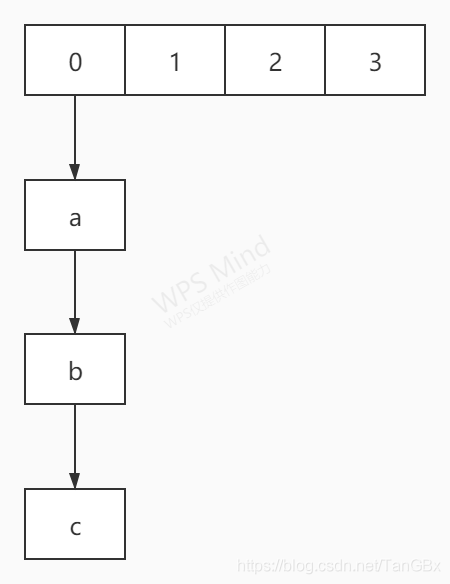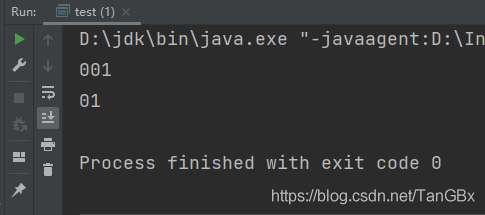Java數據結構之實現哈希表的分離鏈接法
哈希表的分離鏈接法
原理
Hash Table可以看作是一種特殊的數組。他的原理基本上跟數組相同,給他一個數據,經過自己設置的哈希函數變換得到一個位置,並在這個位置當中放置該數據。哦對瞭,他還有個名字叫散列
| 0 | 1 |
| 數據1 | 數據2 |
就像這個數組,0號位置放著數據1,1號位置放數據2
而我們的哈希表則是通過一個函數f(x) 把數據1變成0,把數據2變成1,然後在得到位置插入數據1和數據2。
非常重要的是哈希表的長度為素數最好!!
而且當插入數據大於一半的時候我們要進行擴充!!!
沖突問題產生
現在這個表就是2個數據,所以不會產生什麼沖突,但是若一個數據他通過f(x)計算得到的位置也是0呢?是不是就跟數據1產生瞭沖突,因為數據1已經占據瞭這個位置,你無法進行插入操作。對不對。
所以我們該如何解決這個問題呢,誒,我們肯定是想兩個都可以插入是不是,就像一個炸串一樣把他串起來。如圖

a b c就像一個炸串,而如何實現這個炸串就有多種方式。這裡我們用線性表來實現
線性表實現
我們可以用java自帶的List ArrayList等表,這邊也給出單鏈表的實現方式。
public class MyArray<AnyType> {
我們首先得創建一個內部類用來存放數據,以及保存下個節點
class ArrayNode<AnyType>{
public AnyType data;
public ArrayNode<AnyType> next;
public ArrayNode(AnyType data){this(data,null);}
private ArrayNode(AnyType data,ArrayNode<AnyType> next){
this.data=data;
this.next=next;
}
}//save type node;
設置我們這個線性表所需要的對象,例如size和一個頭節點,以及我們要進行初始化,判斷這個表是否為空等。
private int theSize;//array list size
private ArrayNode<AnyType> head; //head node every data behind it
//init MyArray
public MyArray(){doClear();}
public void clear(){doClear();}
private void doClear(){
theSize=0;
head=new ArrayNode<>(null);
}
//get size and is empty
public int size(){return theSize;}
public boolean isEmpty(){return theSize==0;}
接下來我們需要實現他的基本操作,是否包含,插入,獲得以及刪除。
//contain
public boolean contains(AnyType x){
ArrayNode<AnyType> newNode=head;//get a new node=head
while (newNode.next!=null) {
newNode=newNode.next;
if (newNode.data == x)
return true;
}
return false;
}
//get the data in idx from array
public AnyType get(int idx){return get(idx,head).data;}
private ArrayNode<AnyType> get(int idx,ArrayNode<AnyType> node){
if(idx<0||idx>size())
throw new IndexOutOfBoundsException();//out of length
ArrayNode<AnyType> newNode=node;
//find start head.next
for (int i = 0; i < idx; i++)
newNode=newNode.next;
return newNode;
}
//set data into array
public void set(AnyType x){set(x,head);}
private void set(AnyType x,ArrayNode<AnyType> node){
ArrayNode<AnyType> newNode=node;
while (newNode.next!=null)
newNode=newNode.next;
theSize++;
newNode.next=new ArrayNode<>(x);
}
//remove
public void remove(AnyType x){remove(x,head);}
private void remove(AnyType x,ArrayNode<AnyType> node){
if(!contains(x))
return;
while (node.next!=null){
node=node.next;
if (node.next.data==x)
break;
}
ArrayNode<AnyType> oldNode=node.next;
node.next=null;
node.next=oldNode.next;
}
}
哈希表實現
public class MyHashTable<AnyType>{
//define the things that we need to use
private static final int DEFAULT_SIZE = 10;
private MyArray<AnyType>[] arrays;
private int currentSize;
因為我實現的是學號的存儲
也就是帶0開頭的數據 所以我用字符串
這裡這個myHash就是我實現的簡單哈希函數,即獲得的數據字符串化,得到最後兩個字符
private int myHash(AnyType x){
String s=x.toString();
return Integer.parseInt(s.substring(s.length()-2,s.length()));
}
初始化哈希表,設置的默認大小為10,然後進行素數判斷,如果它不是素數,那麼就找到他的下一個素數作為表的大小。
//init we should ensure that the table size is prime
public MyHashTable(){
ensureTable(nextPrime(DEFAULT_SIZE));
makeEmpty();
}
private void ensureTable(int x){
arrays=new MyArray[x];
for (int i = 0; i < arrays.length; i++)
arrays[i]=new MyArray<>();
}
//make the array empty
public void makeEmpty(){
currentSize=0;
for(MyArray<AnyType> myArray:arrays)
myArray.clear();
}
//size and empty
public int size(){return currentSize;}
public boolean isEmpty(){return currentSize==0;}
基本方法的實現,插入,獲得,刪除,包含
//contain x
public boolean contains(AnyType x){
int position=myHash(x);
return arrays[position].contains(x);
}
//insert x
public void insert(AnyType x){
int position=myHash(x);
if(arrays[position].contains(x))
return;
else if(arrays[position].size()==0)
if(++currentSize>arrays.length)
makeBigger();
arrays[position].set(x);
}
//get idx data
public MyArray<AnyType> get(int idx){ return arrays[idx];}
在這裡,如果插入的時候啦,實際的currentSize大於二分之一表的大小瞭
則進行擴充表
一般擴充表的話,我們是直接兩倍兩倍擴充的。
//makeBigger
public void makeBigger() {
MyArray[] oldArray = arrays;
arrays = new MyArray[2 * arrays.length];
for (int i = 0; i < oldArray.length; i++)
arrays[i] = oldArray[i];
}
下一個素數查找,如果他是偶數,則給他加1這樣可以大大減少開銷。
然後進行下一個素數判斷,奇數當中找素數。
//nextPrime
private int nextPrime(int i){
if(i%2==0)
i++;
for (; !isPrime(i); i+=2);//ensure i is jishu
return i;
}
是否為素數判斷,如果為2則范圍true
如果是1或者為偶數則返回false
都不滿足則從三開始,他的平方小於輸入的數,用奇數進行操作,因為用偶數的話,前面那個2就直接判斷瞭,所以我們用奇數,大大減少開銷。
我們也可以設置他的判斷條件是小於輸入的二分之一,但是我們用平方進行判斷大大減少瞭開銷,而且對於奇數來說是十分有效果的。
//is Prime
private boolean isPrime(int i){
if(i==2||i==3)
return true;
if(i==1||i%2==0)
return false;
for (int j = 3; j*j<=i ; j+=2)
if (i%j==0)
return false;
return true;
}
}
測試
public class test {
public static void main(String[] args) {
MyHashTable<String> a=new MyHashTable<>();
a.insert("001");
a.insert("01");
for(int i=1;i<a.get(1).size()+1;i++){
System.out.println(a.get(1).get(i));
}
}
}
結果

到此這篇關於Java數據結構之實現哈希表的分離鏈接法的文章就介紹到這瞭,更多相關Java哈希表的分離鏈接法內容請搜索WalkonNet以前的文章或繼續瀏覽下面的相關文章希望大傢以後多多支持WalkonNet!
推薦閱讀:
- 帶你瞭解Java數據結構和算法之鏈表
- 深入瞭解Java數據結構和算法之堆
- Java實現跳躍表的示例詳解
- 帶你瞭解Java數據結構和算法之數組
- Java實現單鏈表SingleLinkedList增刪改查及反轉 逆序等